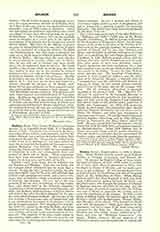

Holbein, HANS (THE ELDER HOLBEIN), a German painter; b. at Augsburg about 1460; d. at Isenheim, Alsace, in 1524. Except that he was born in the Bavarian center of art, culture, and commerce, and that his father, Michael, was a well-to-do leather-worker, little is known of his early life. He may have studied in the studio of the great Schongauer, and some authorities state that he married the daughter of the engraver and painter Brickmaer (von Stetten). He is registered among the citizens of Ulm in 1499; he was established in Frankfort in 1501 and subsequently lived and painted at Basle and in Alsace. These wanderings may have been occasioned by financial embarrassments, for he was poor and in debt all his life.
Holbein’s early work shows that he followed van der Weyden and Memling. Then the van Eycks and the Cologne school influenced him for more than a decade. In this, his “dry” period of painting, his subjects were chiefly from the Passion, and, although they exhibit crude grouping and color, and a naive technique, they nevertheless evince a profound sentiment of sincerity and devotion. He was one of the first painters, if not the first, in Germany to avoid angles, lines, and sharp folds in his elaborate draperies. Augsburg was on the high road between Germany and Italy, and Holbein, drinking deeply of Italian culture substituted the softer Southern elements for the precise and archaic German methods. He was one of the first to paint a Renaissance type of background, and to use architectural decoration in his pictures; and in this he became a master. This emancipation of painting (1512-22), begun by the elder Holbein, was to be completed by his son Hans. Thus the elder Holbein was a pioneer and leader in the transformation of German art. The majority of the great critics incline to this opinion, while others aver that his poverty and debts were due to his long and notorious resistance to Italian influence. He was a spirited and robust, if sometimes vulgar, painter, a man of imagination and power, possessing a splendid capacity for depicting character. His merits have long been overshadowed by the fame of his son.
The earliest important work of the elder Holbein is a “Madonna and Child” (1492) now in the Moritz Kapelle, Nuremberg. In 1493 he became well known by his altar-piece in Weingarten Abbey; but the most famous of his works is the altar of the basilica of St. Paul (now in the Augsburg Gallery), for it contains a portrait of himself and his two sons, Ambrose and Hans; and the father is pointing with pride to young Hans as if predicting the lad’s future greatness. At Frankfort, in 1501, Holbein painted a large and important altar-piece for the Dominicans and for some time after seems to have won pecuniary success. Forged documents and false inscriptions for a long time ascribed works to the son which modern authorities ascribe to the father. Today the elder Holbein enters into his own. The beautiful “Conception”, painted in 1512 (Augsburg Gallery), and the altar-piece of St. Sebastian (Munich), a triptych with the “Annunciation” and Sts. Elizabeth and Barbara occupying its wings, are two notable pictures recently proved to be by the elder, and not the younger, Holbein. The St. Sebastian altar-piece is generally regarded as his greatest work. His “Madonna Enthroned” is preserved in the Germanic Museum, at Nuremberg, while two portraits by him (probably a man and wife) are in the Hampton Court collection. The sketch books of this prolific artist, preserved at Berlin and Copenhagen, are filled with portraits, chiefly in silver-point, the noteworthy faces therein being the Emperor Maximilian, his fool, Kunz von der Rosen, the Fuggers, and other men conspicuous in commerce and at Court. He and his brother Sigmund painted together—how long, and on what pictures, cannot be discovered; but Hans always signed the work. He gave young Hans his first lessons, and endowed him with his virile force and immense capacity for characterization. About 1520 Holbein was in Alsace and sought refuge with the monks of Isenheim. After his death it is recorded that his son claimed his brushes, paints, and sketch books from the monastery.
LEIGH HUNT

